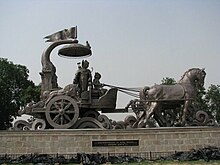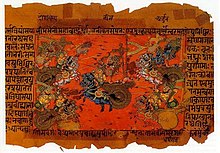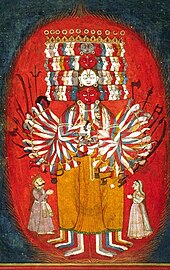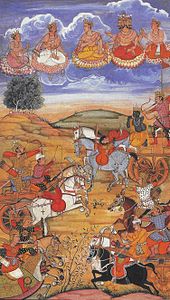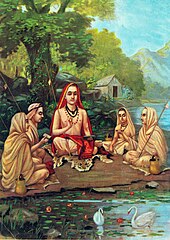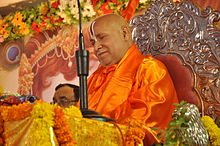Bhagavad Gita
Definition
| Bhagavad Gita | |
|---|---|
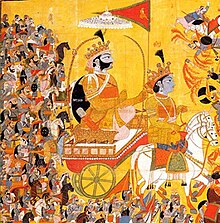 Krishna and Arjuna at Kurukshetra, c. 1820 painting | |
| Information | |
| Religion | Hinduism |
| Author | Veda Vyasa |
| Language | Sanskrit |
| Verses | 700 |
The Gita is set in a narrative framework of a dialogue between Pandava prince Arjuna and his guide and charioteer Lord Krishna. Facing the duty as a warrior to fight the Dharma Yudhha or righteous war between Pandavas and Kauravas, Arjuna is counselled by Lord Krishna to "fulfill his Kshatriya (warrior) duty as a warrior and establish Dharma." Inserted in this appeal to kshatriya dharma (chivalry) " is a dialogue ... between diverging attitudes concerning methods toward the attainment of liberation (moksha)".
The Bhagavad Gita presents a synthesis of the concept of Dharma, theistic bhakti, the yogic ideals of moksha through jnana, bhakti, karma, and Raja Yoga (spoken of in the 6th chapter) and Samkhya philosophy.
Numerous commentaries have been written on the Bhagavad Gita with widely differing views on the essentials. Vedanta commentators read varying relations between Self and Brahman in the text: Advaita Vedanta sees the non-dualism of Atman (soul) and Brahman as its essence, whereas Bhedabheda and Vishishtadvaita see Atman and Brahman as both different and non-different, and Dvaita sees them as different. The setting of the Gita in a battlefield has been interpreted as an allegory for the ethical and moral struggles of the human life.
The Bhagavad Gita's call for selfless action inspired many leaders of the Indian independence movement including Bal Gangadhar Tilak and Mahatma Gandhi. Gandhi referred to the Gita as his "spiritual dictionary".
Composition and significance
Authorship
The epic Mahabharata is traditionally ascribed to the Sage Vyasa; the Bhagavad Gita, comprising Chapters Twenty-five to Forty-two of the Mahabharata's Bhishma Parva, is also ascribed to him.
Date of composition
Theories on the date of composition of the Gita vary considerably. Scholars accept dates from the fifth century to the second century BCE as the probable range. Professor Jeaneane Fowler, in her commentary on the Gita, considers second century BCE to be the likely date of composition. Kashi Nath Upadhyaya, a Gita scholar, on the basis of the estimated dates of Mahabharata, Brahma sutras, and other independent sources, concludes that the Bhagavad Gita was composed in the fifth or fourth century BCE.
It is generally agreed that, "Unlike the Vedas, which have to be preserved letter-perfect, the Gita was a popular work whose reciters would inevitably conform to changes in language and style", so the earliest "surviving" components of this dynamic text are believed to be no older than the earliest "external" references we have to the Mahabharata epic, which may include an allusion in Panini's fourth century BCE grammar. It is estimated that the text probably reached something of a "final form" by the early Gupta period (about the 4th century CE). The actual dates of composition of the Gita remain unresolved.
Bhagavad Gita in ancient sanskrit literature
There is no reference to the Bhagavad Gita in Buddhist literature, the Tripitaka. The Buddha refers to 3 Vedas rather than 4 Vedas.
Hindu synthesis and smriti
Due to its presence in the Mahabharata, the Bhagavad Gita is classified as a Smriti text or "that which is remembered". The smriti texts of the period between 200 BCE and 100 CE belong to the emerging "Hindu Synthesis", proclaiming the authority of the Vedas while integrating various Indian traditions and religions. Acceptance of the Vedas became a central criterion for defining Hinduism over and against the heterodoxies, which rejected the Vedas.
The so-called "Hindu Synthesis" emerged during the early Classical period (200 BCE – 300 CE) of Hinduism. According to Alf Hiltebeitel, a period of consolidation in the development of Hinduism took place between the time of the late Vedic Upanishad (ca. 500 BCE) and the period of the rise of the Guptas (ca. 320–467 CE) which he calls the "Hindu Synthesis", "Brahmanic Synthesis", or "Orthodox Synthesis". It developed in interaction with other religions and peoples:
The Bhagavad Gita is the sealing achievement of this Hindu Synthesis, incorporating various religious traditions. According to Hiltebeitel, Bhakti forms an essential ingredient of this synthesis, which incorporates Bhakti into Vedanta. According to Deutsch and Dalvi, the Bhagavad Gita attempts "to forge a harmony" between different strands of Indian thought: jnana, dharma and bhakti.Deutsch and Dalvi note that the authors of the Bhagavad Gita "must have seen the appeal of the soteriologies both of the "heterodox" traditions of Buddhism and Jainism and of the more "orthodox" ones of Samkhya and Yoga", while the Brahmanic tradition emphasised "the significance of dharma as the instrument of goodness". Scheepers mentions the Bhagavat Gita as a Brahmanical text which uses the shramanic and Yogic terminology to spread the Brahmanic idea of living according to one's duty or dharma, in contrast to the yogic ideal of liberation from the workings of karma. According to Basham,
Bhagavad Gita as a synthesis:
The influence of the Bhagavad Gita was such, that its synthesis was adapted to and incorporated into specific Indian traditions. Nicholson mentions the Shiva Gita as an adaptation of the Vishnu-oriented Bhagavat Gita into Shiva-oriented terminology, and the Isvara Gita as borrowing entire verses from the Krishna-oriented Bhagavad Gita and placing them into a new Shiva-oriented context.
Status
The Bhagavad Gita is part of the Prasthanatrayi, which also includes the Upanishads and Brahma sutras. These are the key texts for the Vedanta, which interprets these texts to give a unified meaning. Advaita Vedanta sees the non-dualism of Atman and Brahman as its essence, whereas Bhedabheda and Vishishtadvaita see Atman and Brahman as both different and non-different, and Dvaita sees them as different. In recent times the Advaita interpretation has gained worldwide popularity, due to the Neo-Vedanta of Vivekananda and Radhakrishnan, while the Achintya Bheda Abheda interpretation has gained worldwide popularity via the Hare Krishnas, a branch of Gaudiya Vaishnavism.
Although early Vedanta gives an interpretation of the sruti texts of the Upanishads, and its main commentary the Brahman Sutras, the popularity of the Bhagavad Gita was such that it could not be neglected.It is referred to in the Brahman Sutras, and Shankara, Bhaskara and Ramanuja all three wrote commentaries on it. The Bhagavad Gita is different from the Upanishads in format and content, and accessible to all, in contrast to the sruti, which are only to be read and heard by the higher castes.
Some branches of Hinduism give it the status of an Upanishad, and consider it to be a Śruti or "revealed text". According to Pandit, who gives a modern-orthodox interpretation of Hinduism, "since the Bhagavad Gita represents a summary of the Upanishadic teachings, it is sometimes called 'the Upanishad of the Upanishads'."
Content
Narrative
In the epic Mahabharata, after Sanjaya—counsellor of the Kuru king Dhritarashtra—returns from the battlefield to announce the death of Bhishma, he begins recounting the details of the Mahabharata war. Bhagavad Gita forms the content of this recollection. The Gita begins before the start of the climactic Kurukshetra War, where the Pandava prince Arjuna is filled with doubt on the battlefield. He asks Krishna to drive to the center of the battlefield so that he can get a good look at both armies. Realising that his enemies are his own relatives, beloved friends, and revered teachers, he turns to his charioteer and guide, God Incarnate Lord Shri Krishna, for advice. Responding to Arjuna's confusion and moral dilemma, Krishna explains to Arjuna his duties as a warrior and prince, elaborating on a variety of philosophical concepts.After Krishna stops talking to Arjuna, Yudistra leaves his chariot to seek blessings from Drona, and the war starts.
Characters
- Arjuna, one of the Pandavas
- Lord Shri Krishna, Arjuna's charioteer and guru who was actually an incarnation of Lord Vishnu
- Sanjaya, counselor of the Kuru king Dhritarashtra
- Dhritarashtra, Kuru king.
Chapters
Bhagavad Gita comprises 18 chapters (section 25 to 42) in the Bhishma Parva of the epic Mahabharata and consists of 700 verses. Because of differences in recensions, the verses of the Gita may be numbered in the full text of the Mahabharata as chapters 6.25–42 or as chapters 6.23–40. According to the recension of the Gita commented on by Adi Shankara, a prominent philosopher of the Vedanta school, the number of verses is 700, but there is evidence to show that old manuscripts had 745 verses. The verses themselves, composed with similes and metaphors, are poetic in nature. The verses mostly employ the range and style of the Sanskrit Anustubh metre (chhandas), and in a few expressive verses the Tristubh metre is used.
The Sanskrit editions of the Gita name each chapter as a particular form of yoga. However, these chapter titles do not appear in the Sanskrit text of the Mahabharata. Swami Chidbhavananda explains that each of the eighteen chapters is designated as a separate yoga because each chapter, like yoga, "trains the body and the mind". He labels the first chapter "Arjuna Vishada Yogam" or the "Yoga of Arjuna's Dejection". Sir Edwin Arnold translates this chapter as "The Distress of Arjuna"
-
- Gita Dhyanam: (contains 9 verses) The Gita Dhyanam is not a part of the main Bhagavad Gita, but it is commonly published with the Gītā as a prefix. The verses of the Gita Dhyanam (also called Gītā Dhyāna or Dhyāna Ślokas) offer salutations to a variety of sacred scriptures, figures, and entities, characterise the relationship of the Gītā to the Upanishads, and affirm the power of divine assistance. It is a common practice to recite these before reading the Gita.
1.Prathama adhyaya (The Distress of Arjuna contains 46 verses): Arjuna has requested Krishna to move his chariot between the two armies. His growing dejection is described as he fears losing friends and relatives as a consequence of war.
2.Sankhya yoga (The Book of Doctrines contains 72 verses): After asking Krishna for help, Arjuna is instructed into various subjects such as, Karma yoga, Gyaana yoga, Sankhya yoga, Buddhi yoga and the immortal nature of the soul. Sankhya here refers to one of six orthodox schools of the Hindu Philosophy. This chapter is often considered the summary of the entire Bhagavad Gita.
3. Karma yoga (Virtue in Work or Virtue Of Actions contains 43 verses): Krishna explains how Karma yoga, i.e. performance of prescribed duties, but without attachment to results, is the appropriate course of action for Arjuna.
4. Gyaana–Karma-Sanyasa yoga (The Religion of Knowledge contains 42 verses): Krishna reveals that he has lived through many births, always teaching yoga for the protection of the pious and the destruction of the impious and stresses the importance of accepting a guru.
5.Karma–Sanyasa yoga (Religion by Renouncing Fruits of Works contains 29 verses): Arjuna asks Krishna if it is better to forgo action or to act ("renunciation or discipline of action"). Krishna answers that both are ways to the same goal, but that acting in Karma yoga is superior.
6.Dhyan yoga or Atmasanyam yoga (Religion by Self-Restraint contains 47 verses): Krishna describes the Ashtanga yoga. He further elucidates the difficulties of the mind and the techniques by which mastery of the mind might be gained.
7.Gyaana–ViGyaana yoga (Religion by Discernment contains 30 verses): Krishna describes the absolute reality and its illusory energy Maya.
8.Aksara–Brahma yoga (Religion by Devotion to the One Supreme God contains 28 verses): This chapter contains eschatology of the Bhagavad Gita. Importance of the last thought before death, differences between material and spiritual worlds, and light and dark paths that a soul takes after death are described.
9.Raja–Vidya–Raja–Guhya yoga (Religion by the Kingly Knowledge and the Kingly Mystery contains 34 verses): Krishna explains how His eternal energy pervades, creates, preserves, and destroys the entire universe. According to theologian Christopher Southgate, verses of this chapter of the Gita are panentheistic, while German physicist and philosopher Max Bernhard Weinstein deems the work pandeistic.
10.Vibhuti–Vistara–yoga (Religion by the Heavenly Perfections contains 42 verses): Krishna is described as the ultimate cause of all material and spiritual existence. Arjuna accepts Krishna as the Supreme Being, quoting great sages who have also done so.
11.Visvarupa–Darsana yoga (The Manifesting of the One and Manifold contains 55 verses): On Arjuna's request, Krishna displays his "universal form" (Viśvarūpa), a theophany of a being facing every way and emitting the radiance of a thousand suns, containing all other beings and material in existence.
12.Bhakti yoga (The Religion of Faith contains 20 verses): In this chapter Krishna glorifies the path of devotion to God. Krishna describes the process of devotional service (Bhakti yoga). He also explains different forms of spiritual disciplines.
13.Ksetra–Ksetrajna Vibhaga yoga (Religion by Separation of Matter and Spirit contains 35 verses): The difference between transient perishable physical body and the immutable eternal soul is described. The difference between individual consciousness and universal consciousness is also made clear.
14.Gunatraya–Vibhaga yoga (Religion by Separation from the Qualities contains 27 verses): Krishna explains the three modes (gunas) of material nature pertaining to goodness, passion, and nescience. Their causes, characteristics, and influence on a living entity are also described.
15.Purusottama yoga (Religion by Attaining the Supreme contains 20 verses): Krishna identifies the transcendental characteristics of God such as, omnipotence, omniscience, and omnipresence.Krishna also describes a symbolic tree (representing material existence), which has its roots in the heavens and its foliage on earth. Krishna explains that this tree should be felled with the "axe of detachment", after which one can go beyond to his supreme abode.
16.Daivasura–Sampad–Vibhaga yoga (The Separateness of the Divine and Undivine contains 24 verses): Krishna identifies the human traits of the divine and the demonic natures. He counsels that to attain the supreme destination one must give up lust, anger, greed, and discern between right and wrong action by discernment through Buddhi and evidence from the scriptures.
17.Sraddhatraya-Vibhaga yoga (Religion by the Threefold Kinds of Faith contains 28 verses): Krishna qualifies the three divisions of faith, thoughts, deeds, and even eating habits corresponding to the three modes (gunas).
18.Moksha–Sanyasa yoga (Religion by Deliverance and Renunciation contains 78 verses): In this chapter, the conclusions of previous seventeen chapters are summed up. Krishna asks Arjuna to abandon all forms of dharma and simply surrender unto him and describes this as the ultimate perfection of life.
7.Gyaana–ViGyaana yoga (Religion by Discernment contains 30 verses): Krishna describes the absolute reality and its illusory energy Maya.
8.Aksara–Brahma yoga (Religion by Devotion to the One Supreme God contains 28 verses): This chapter contains eschatology of the Bhagavad Gita. Importance of the last thought before death, differences between material and spiritual worlds, and light and dark paths that a soul takes after death are described.
9.Raja–Vidya–Raja–Guhya yoga (Religion by the Kingly Knowledge and the Kingly Mystery contains 34 verses): Krishna explains how His eternal energy pervades, creates, preserves, and destroys the entire universe. According to theologian Christopher Southgate, verses of this chapter of the Gita are panentheistic, while German physicist and philosopher Max Bernhard Weinstein deems the work pandeistic.
10.Vibhuti–Vistara–yoga (Religion by the Heavenly Perfections contains 42 verses): Krishna is described as the ultimate cause of all material and spiritual existence. Arjuna accepts Krishna as the Supreme Being, quoting great sages who have also done so.
11.Visvarupa–Darsana yoga (The Manifesting of the One and Manifold contains 55 verses): On Arjuna's request, Krishna displays his "universal form" (Viśvarūpa), a theophany of a being facing every way and emitting the radiance of a thousand suns, containing all other beings and material in existence.
12.Bhakti yoga (The Religion of Faith contains 20 verses): In this chapter Krishna glorifies the path of devotion to God. Krishna describes the process of devotional service (Bhakti yoga). He also explains different forms of spiritual disciplines.
13.Ksetra–Ksetrajna Vibhaga yoga (Religion by Separation of Matter and Spirit contains 35 verses): The difference between transient perishable physical body and the immutable eternal soul is described. The difference between individual consciousness and universal consciousness is also made clear.
14.Gunatraya–Vibhaga yoga (Religion by Separation from the Qualities contains 27 verses): Krishna explains the three modes (gunas) of material nature pertaining to goodness, passion, and nescience. Their causes, characteristics, and influence on a living entity are also described.
15.Purusottama yoga (Religion by Attaining the Supreme contains 20 verses): Krishna identifies the transcendental characteristics of God such as, omnipotence, omniscience, and omnipresence.Krishna also describes a symbolic tree (representing material existence), which has its roots in the heavens and its foliage on earth. Krishna explains that this tree should be felled with the "axe of detachment", after which one can go beyond to his supreme abode.
16.Daivasura–Sampad–Vibhaga yoga (The Separateness of the Divine and Undivine contains 24 verses): Krishna identifies the human traits of the divine and the demonic natures. He counsels that to attain the supreme destination one must give up lust, anger, greed, and discern between right and wrong action by discernment through Buddhi and evidence from the scriptures.
17.Sraddhatraya-Vibhaga yoga (Religion by the Threefold Kinds of Faith contains 28 verses): Krishna qualifies the three divisions of faith, thoughts, deeds, and even eating habits corresponding to the three modes (gunas).
18.Moksha–Sanyasa yoga (Religion by Deliverance and Renunciation contains 78 verses): In this chapter, the conclusions of previous seventeen chapters are summed up. Krishna asks Arjuna to abandon all forms of dharma and simply surrender unto him and describes this as the ultimate perfection of life.
Themes
Dharma
The term dharma has a number of meanings. Fundamentally, it means "what is right". Early in the text, responding to Arjuna's despondency, Krishna asks him to follow his swadharma, "the dharma that belongs to a particular man (Arjuna) as a member of a particular varna, (i.e., the kshatriya)." Many traditional followers accept and believe that every man is unique in nature(svabhava) and hence svadharma for each and every individual is also unique and must be followed strictly with sole bhakthi and shraddha.
According to Vivekananda:
Dharma and heroism
The Bhagavad Gita is set in the narrative frame of the Mahabharata, which values heroism, "energy, dedication and self-sacrifice", as the dharma, "holy duty" of the Kshatriya (Warrior). Axel Michaels in his book Hinduism: Past and Present writes that in the Bhagavad Gita, Arjuna is "exhorted by his charioteer, Kṛiṣhṇa, among others, to stop hesitating and fulfil his Kṣatriya (warrior) duty as a warrior and kill."
According to Malinar, the dispute between the two parties in the Mahabharata centres on the question how to define "the law of heroism". Malinar gives a description of the dharma of a Kshatriya (warrior) based on the Udyogaparvan, the fifth book of the Mahabharata:
Michaels defines heroism as "power assimilated with interest in salvation". According to Michaels:
According to Malinar, "Arjuna's crisis and some of the arguments put forward to call him to action are connected to the debates on war and peace in the UdP [Udyoga Parva]". According to Malinar, the UdPemphasises that one must put up with fate and, the BhG personalises the surrender one's personal interests to the power of destiny by "propagating the view that accepting and enacting the fatal course of events is an act of devotion to this god [Krsna] and his cause."
Modern interpretations of dharma
Svadharma and svabhava
The eighteenth chapter of the Gita examines the relationship between svadharma and svabhava. This chapter uses the gunas of Shankya philosophy to present a series of typologies, and uses the same term to characterise the specific activities of the four varnas, which are distinguished by the "gunas proceeding from their nature."
Aurobindo modernises the concept of dharma and svabhava by internalising it, away from the social order and its duties towards one's personal capacities, which leads to a radical individualism, "finding the fulfilment of the purpose of existence in the individual alone." He deduced from the Gita the doctrine that "the functions of a man ought to be determined by his natural turn, gift, and capacities", that the individual should "develop freely" and thereby would be best able to serve society.
Gandhi's view differed from Aurobindo's view. He recognised in the concept of swadharma his idea of swadeshi, the idea that "man owes his service above all to those who are nearest to him by birth and situation." To him, swadeshi was "swadharma applied to one's immediate environment."
The Field of Dharma
The first reference to dharma in the Bhagavad Gita occurs in its first verse, where Dhritarashtra refers to the Kurukshetra, the location of the battlefield, as the Field of Dharma, "The Field of Righteousness or Truth". According to Fowler, dharma in this verse may refer to the sanatana dharma, "what Hindus understand as their religion, for it is a term that encompasses wide aspects of religious and traditional thought and is more readily used for ""religion". Therefore, 'Field of action' implies the field of righteousness, where truth will eventually triumph.
"The Field of Dharma" is also called the "Field of action" by Sri Aurobindo, a freedom fighter and philosopher. Sarvapalli Radhakrishnan, a philosopher and the second president of India, saw "The Field of Dharma" as the world (Bhavsagar), which is a "battleground for moral struggle".
Allegory of war
Unlike any other religious scripture, the Bhagavad Gita broadcasts its message in the centre of the battlefield. The choice of such an unholy ambience for the delivery of a philosophical discourse has been an enigma to many commentators. Several modern Indian writers have interpreted the battlefield setting as an allegory of "the war within".
Eknath Easwaran writes that the Gita's subject is "the war within, the struggle for self-mastery that every human being must wage if he or she is to emerge from life victorious", and that "The language of battle is often found in the scriptures, for it conveys the strenuous, long, drawn-out campaign we must wage to free ourselves from the tyranny of the ego, the cause of all our suffering and sorrow."
Jorge Angel Livraga also sees the battle as a reflection of the human condition, a necessary inner battle to overcome one's faults. "Arjuna is the image of all humanity. Each one of us wages, or one day will wage, the same battle of Arjuna."
Swami Nikhilananda, takes Arjuna as an allegory of Ātman, Krishna as an allegory of Brahman, Arjuna's chariot as the body, and Dhritarashtra as the ignorance filled mind.
Mohandas Karamchand Gandhi, in his commentary on the Gita, interprets the battle as "an allegory in which the battlefield is the soul and Arjuna, man's higher impulses struggling against evil".
Swami Vivekananda also emphasised that the first discourse in the Gita related to the war could be taken allegorically. Vivekananda further remarked,
In Aurobindo's view, Krishna was a historical figure, but his significance in the Gita is as a "symbol of the divine dealings with humanity", while Arjuna typifies a "struggling human soul". However, Aurobindo rejected the interpretation that the Gita, and the Mahabharata by extension, is "an allegory of the inner life, and has nothing to do with our outward human life and actions":
Swami Chinmayananda writes:
Promotion of just war and duty
Other scholars such as Steven Rosen, Laurie L. Patton and Stephen Mitchell have seen in the Gita a religious defense of the warrior class's (Kshatriya Varna) duty (svadharma), which is to conduct combat and war with courage and do not see this as only an allegorical teaching, but also a real defense of just war.
Indian independence leaders like Lala Lajpat Rai and Bal Gangadhar Tilak saw the Gita as a text which defended war when necessary and used it to promote war against the British Empire. Lajpat Rai wrote an article on the "Message of the Bhagavad Gita". He saw the main message as the bravery and courage of Arjuna to fight as a warrior. Bal Gangadhar Tilak saw the Gita as defending killing when necessary for the betterment of society, such as, for example, the killing of Afzal Khan.
According to J. N. Farquhar:
Moksha: Liberation
Liberation or moksha in Vedanta philosophy is not something that can be acquired or reached. Ātman (Soul), the goal of moksha, is something that is always present as the essence of the self, and can be revealed by deep intuitive knowledge. While the Upanishads largely uphold such a monistic viewpoint of liberation, the Bhagavad Gita also accommodates the dualistic and theistic aspects of moksha. The Gita, while occasionally hinting at impersonal Brahman as the goal, revolves around the relationship between the Self and a personal God or Saguna Brahman. A synthesis of knowledge, devotion, and desireless action is given as a prescription for Arjuna's despondence; the same combination is suggested as a way to moksha. Winthrop Sargeant further explains, "In the model presented by the Bhagavad Gītā, every aspect of life is in fact a way of salvation."
Yoga
Yoga in the Bhagavad Gita refers to the skill of union with the ultimate reality or the Absolute. In his commentary, Zaehner says that the root meaning of yoga is "yoking" or "preparation"; he proposes the basic meaning "spiritual exercise", which conveys the various nuances in the best way.
Sivananda's commentary regards the eighteen chapters of the Bhagavad Gita as having a progressive order, by which Krishna leads "Arjuna up the ladder of Yoga from one rung to another." The influential commentator Madhusudana Sarasvati divided the Gita's eighteen chapters into three sections of six chapters each. Swami Gambhirananda characterises Madhusudana Sarasvati's system as a successive approach in which Karma yoga leads to Bhakti yoga, which in turn leads to Gyaana yoga:
- Chapters 1–6 = Karma yoga, the means to the final goal
- Chapters 7–12 = Bhakti yoga or devotion
- Chapters 13–18 = Gyaana yoga or knowledge, the goal itself
Karma yoga
As noted by various commentators, the Bhagavad Gita offers a practical approach to liberation in the form of Karma yoga. The path of Karma yoga upholds the necessity of action. However, this action is to be undertaken without any attachment to the work or desire for results. Bhagavad Gita terms this "inaction in action and action in inaction (4.18)". The concept of such detached action is also called Nishkam Karma, a term not used in the Gita. Lord Krishna, in the following verses, elaborates on the role actions, performed without desire and attachment, play in attaining freedom from material bondage and transmigration:
Mohandas Karamchand Gandhi writes, "The object of the Gita appears to me to be that of showing the most excellent way to attain self-realization", and this can be achieved by selfless action, "By desireless action; by renouncing fruits of action; by dedicating all activities to God, i.e., by surrendering oneself to Him body and soul." Gandhi called the Gita "The Gospel of Selfless Action". To achieve true liberation, it is important to control all mental desires and tendencies to enjoy sense pleasures. The following verses illustrate this:
Bhakti yoga
The introduction to chapter seven of the Bhagavad Gita explains bhakti as a mode of worship which consists of unceasing and loving remembrance of God. Faith (Śraddhā) and total surrender to a chosen God (Ishta-deva) are considered to be important aspects of bhakti. Theologian Catherine Cornille writes, "The text [of the Gita] offers a survey of the different possible disciplines for attaining liberation through knowledge (Gyaana), action (karma), and loving devotion to God (bhakti), focusing on the latter as both the easiest and the highest path to salvation." M. R. Sampatkumaran, a Bhagavad Gita scholar, explains in his overview of Ramanuja's commentary on the Gita, "The point is that mere knowledge of the scriptures cannot lead to final release. Devotion, meditation, and worship are essential."Ramakrishna believed that the essential message of the Gita could be obtained by repeating the word Gita several times, "'Gita, Gita, Gita', you begin, but then find yourself saying 'ta-Gi, ta-Gi, ta-Gi'. Tagimeans one who has renounced everything for God." In the following verses, Krishna elucidates the importance of bhakti:
Radhakrishnan writes that the verse 11.55 is "the essence of bhakti" and the "substance of the whole teaching of the Gita":
Jnana yoga
Jnana yoga is the path of wisdom, knowledge, and direct experience of Brahman as the ultimate reality. The path renounces both desires and actions, and is therefore depicted as being steep and very difficult in the Bhagavad Gita. This path is often associated with the non-dualistic Vedantic belief of the identity of the Ātman with the Brahman. For the followers of this path, the realisation of the identity of Ātman and Brahman is held as the key to liberation.
Pancaratra Agama
According to Dennis Hudson, there is an overlap between Vedic and Tantric rituals with the teachings found in the Bhagavad Gita. He places the Pancaratra Agama in the last three or four centuries of 1st-millennium BCE, and proposes that both the tantric and vedic, the Agama and the Gita share the same Vasudeva-Krishna roots. Some of the ideas in the Bhagavad Gita connect it to the Shatapatha Brahmana of Yajurveda. The Shatapatha Brahmana, for example, mentions the absolute Purusha who dwells in every human being. A story in this vedic text, states Hudson, highlights the meaning of the name Vasudeva as the 'shining one (deva) who dwells (vasu) in all things and in whom all things dwell', and the meaning of Vishnu to be the 'pervading actor'. In Bhagavad Gita, similarly, 'Krishna identified himself both with Vasudeva, Vishnu and their meanings'. The ideas at the center of Vedic rituals in Shatapatha Brahmana and the teachings of the Bhagavad Gita revolve around this absolute Person, the primordial genderless absolute, which is same as the goal of Pancaratra Agama and Tantra.
Commentaries and translations
The Bhagavad Gita was first translated into English in the year 1785, by Charles Wilkins on the orders of the Court of Directors of the East India Company, with special interest shown by Warren Hastings, the then Governor General of India. This edition had an introduction to the Gita by Warren Hastings. Soon the work was translated into other European languages such as German, French and Russian.
In 1849, the Weleyan Mission Press, Bangalore published The Bhagavat-Geeta, Or, Dialogues of Krishna and Arjoon in Eighteen Lectures, with Sanskrit, Canarese and English in parallel columns, edited by Rev. John Garrett, and the efforts being supported by Sir. Mark Cubbon
Bhagavad Gita integrates various schools of thought, notably Vedanta, Samkhya and Yoga, and other theistic ideas. It remains a popular text for commentators belonging to various philosophical schools. However, its composite nature also leads to varying interpretations of the text. In the words of Mysore Hiriyanna,
Richard H. Davis cites Callewaert & Hemraj's 1982 count of 1891 BG translations in 75 languages, including 273 in English.
Classical commentaries
Śaṅkara
The oldest and most influential medieval commentary was that of Adi Shankara (788–820 CE), also known as Shankaracharya (Sanskrit: Śaṅkarācārya). Shankara's commentary was based on a recension of the Gita containing 700 verses, and that recension has been widely adopted by others.
Rāmānuja
Ramanujacharya's commentary chiefly seeks to show that the discipline of devotion to God (Bhakti yoga) is the way of salvation.
Madhva
Madhva, a commentator of the Dvaita Vedanta school, whose dates are given either as (1199–1276 CE) or as (1238–1317 CE), also known as Madhvacharya (Sanskrit: Madhvācārya), wrote a commentary on the Bhagavad Gita, which exemplifies the thinking of the "dualist" school. Winthrop Sargeant quotes a dualistic assertion of the Madhva's school that there is "an eternal and complete distinction between the Supreme, the many souls, and matter and its divisions". His commentary on the Gita is called Gita Bhāshya. It has been annotated on by many ancient pontiffs of Dvaita Vedantaschool like Padmanabha Tirtha, Jayatirtha, and Raghavendra Tirtha.
In the Shaiva tradition, the renowned philosopher Abhinavagupta (10–11th century CE) has written a commentary on a slightly variant recension called Gitartha-Samgraha.
Others
Other classical commentators include
- Bhāskara
- Nimbarka (1162 CE)
- Vidyadhiraja Tirtha, Vallabha (1479 CE)
- Madhusudana Saraswati,
- Raghavendra Tirtha,
- Vanamali Mishra,
- Chaitanya Mahaprabhu (1486 CE),
- Dnyaneshwar (1275–1296 CE) translated and commented on the Gita in Marathi, in his book Dnyaneshwari.
Independence movement
At a time when Indian nationalists were seeking an indigenous basis for social and political action, Bhagavad Gita provided them with a rationale for their activism and fight against injustice. Among nationalists, notable commentaries were written by Bal Gangadhar Tilak and Mahatma Gandhi, who used the text to help inspire the Indian independence movement. Tilak wrote his commentary Shrimadh Bhagvad Gita Rahasya while in jail during the period 1910–1911 serving a six-year sentence imposed by the British colonial government in India for sedition. While noting that the Gita teaches possible paths to liberation, his commentary places most emphasis on Karma yoga. No book was more central to Gandhi's life and thought than the Bhagavad Gita, which he referred to as his "spiritual dictionary". During his stay in Yeravda jail in 1929, Gandhi wrote a commentary on the Bhagavad Gita in Gujarati. The Gujarati manuscript was translated into English by Mahadev Desai, who provided an additional introduction and commentary. It was published with a foreword by Gandhi in 1946. Mahatma Gandhi expressed his love for the Gita in these words:
Hindu revivalism
Although Vivekananda did not write any commentaries on the Bhagavad Gita, his works contained numerous references to the Gita, such as his lectures on the four yogas – Bhakti, Gyaana, Karma, and Raja. Through the message of the Gita, Vivekananda sought to energise the people of India to claim their own dormant but strong identity. Bankim Chandra Chattopadhyay thought that the answer to the problems that beset Hindu society was a revival of Hinduism in its purity, which lay in the reinterpretation of Bhagavad Gita for a new India. Aurobindo saw Bhagavad Gita as a "scripture of the future religion" and suggested that Hinduism had acquired a much wider relevance through the Gita. Sivananda called Bhagavad Gita "the most precious jewel of Hindu literature" and suggested its introduction into the curriculum of Indian schools and colleges. In the lectures Chinmayananda gave, on tours undertaken to revive the moral and spiritual values of the Hindus, he borrowed the concept of Gyaana yajna, or the worship to invoke divine wisdom, from the Gita. He viewed the Gita as an universal scripture to turn a person from a state of agitation and confusion to a state of complete vision, inner contentment, and dynamic action. Teachings of International Society for Krishna Consciousness (ISKCON), a Gaudiya Vaishnava religious organisation which spread rapidly in North America in the 1970s and 1980s, are based on a translation of the Gita called Bhagavad-Gītā As It Is by A.C. Bhaktivedanta Swami Prabhupada. These teachings are also illustrated in the dioramas of Bhagavad-gita Museum in Los Angeles, California.
Other modern commentaries
Among notable modern commentators of the Bhagavad Gita are Bal Gangadhar Tilak, Vinoba Bhave, Mohandas Karamchand Gandhi, Sri Aurobindo, Sarvepalli Radhakrishnan, Chinmayananda, etc. Chinmayananda took a syncretistic approach to interpret the text of the Gita.
Paramahansa Yogananda's two volume commentary on the Bhagavad Gita, called God Talks With Arjuna: The Bhagavad Gita, was released 1995.
Eknath Easwaran has also written a commentary on the Bhagavad Gita. It examines the applicability of the principles of Gita to the problems of modern life.
The version by A. C. Bhaktivedanta Swami Prabhupāda, entitled Bhagavad-gītā As It Is, is "by far the most widely distributed of all English Gita translations" due to ISKCON efforts. For each verse, he gives the verse in the Sanskrit Devanagari script, followed by a roman transliteration, a gloss for each word, and then a translation and commentary. Its publisher, the Bhaktivedanta Book Trust, estimates sales at twenty-three million copies, a figure which includes the original English edition and secondary translations into fifty-six other languages.
Bhagavad Gita – The song of God written by Swami Mukundananda.
Other notable commentators include Jeaneane Fowler, Ithamar Theodor, Swami Parthasarathy, and Sadhu Vasvani. In 1966, Maharishi Mahesh Yogi published a partial translation.
Scholarly translations
The first English translation of the Bhagavad Gita was done by Charles Wilkins in 1785. In 1981, Larson listed more than 40 English translations of the Gita, stating that "A complete listing of Gita translations and a related secondary bibliography would be nearly endless". He stated that "Overall ... there is a massive translational tradition in English, pioneered by the British, solidly grounded philologically by the French and Germans, provided with its indigenous roots by a rich heritage of modern Indian comment and reflection, extended into various disciplinary areas by Americans, and having generated in our time a broadly based cross-cultural awareness of the importance of the Bhagavad Gita both as an expression of a specifically Indian spirituality and as one of the great religious "classics" of all time." Sanskrit scholar Barbara Stoler Miller produced a translation in 1986 intended to emphasise the poem's influence and current context within English Literature, especially the works of T.S. Eliot, Henry David Thoreau and Ralph Waldo Emerson. The translation was praised by scholars as well as literary criticsand became one of the most continually popular translations to date.
The Gita in other languages
The Gita has also been translated into European languages other than English. In 1808, passages from the Gita were part of the first direct translation of Sanskrit into German, appearing in a book through which Friedrich Schlegel became known as the founder of Indian philology in Germany. Swami Rambhadracharya released the first Braille version of the scripture, with the original Sanskrit text and a Hindi commentary, on 30 November 2007. The former Turkish Scholar-Politician, Bulent Ecevit translated several Sanskrit scriptures, including the Gita, into Turkish. Mahavidwan
Gita Press has published the Gita in multiple Indian languages. R. Raghava Iyengar translated the Gita into Tamil in sandam metre poetic form. The Bhaktivedanta Book Trust publishes the Gita in more than forty languages, including French, German, Spanish, Italian, Polish, Hungarian, Russian, Kazakh, Chinese, Japanese, Vietnamese, Hebrew, Arabic, Swahili, and sixteen Indian languages.
Philological research
The textual development of the Bhagavad Gita has been researched, but the methods of this research have developed since its onset in the late 18th century. According to Adluri and Bagchee, 19th century German Indologists had an anti-Brahmanic stance, due to their "Protestant suspicion of the Brahmans." They conceived of the Mahabharata as an Indo-Germanic war-epic in origin, to which layers of text were added by the later Brahmins, including the Bhagavad Gita. This interpretation was fueled by the search for Germanic origins and identity, in which the Brahmins were antithetical to the pure Aryans. According to Adluri and Bagchee, 20th century Indology professionalized, but remained anti-Brahmanic, though the anti-Brahmanism disappeared from sight and went "underground."
Contemporary popularity
Prime Minister of India, Shri Narendra Modi has strongly pitched the Bhagavad Gita as "India's biggest gift to the world". Shri Modi gifted The Bhagavad Gita to the then President of the United States of America, Mr Barack Obama in 2014 during his US visit.
With the translation and study of the Bhagavad Gita by Western scholars beginning in the early 18th century, the Bhagavad Gita gained a growing appreciation and popularity. According to the Indian historian and writer Khushwant Singh, Rudyard Kipling's famous poem "If—" is "the essence of the message of The Gita in English."
Appraisal
The Bhagavad Gita has been highly praised, not only by prominent Indians including Mohandas Karamchand Gandhi and Sarvepalli Radhakrishnan, but also by Aldous Huxley, Henry David Thoreau, J. Robert Oppenheimer, Ralph Waldo Emerson, Carl Jung, Herman Hesse, Bülent Ecevit and others.
Jawaharlal Nehru, the first Prime Minister of independent India, commented on the Gita:
A. P. J. Abdul Kalam, 11th President of India, despite being a Muslim, used to read Bhagavad Gita and recite mantras.
J. Robert Oppenheimer, American physicist and director of the Manhattan Project, learned Sanskrit in 1933 and read the Bhagavad Gita in the original form, citing it later as one of the most influential books to shape his philosophy of life. Upon witnessing the world's first nuclear test in 1945, he later said he had thought of the quotation "Now I am become Death, the destroyer of worlds", verse 32 from chapter 11 of the Bhagavad Gita.
Adaptations
Philip Glass retold the story of Gandhi's early development as an activist in South Africa through the text of the Gita in the opera Satyagraha (1979). The entire libretto of the opera consists of sayings from the Gita sung in the original Sanskrit. In Douglas Cuomo's Arjuna's dilemma, the philosophical dilemma faced by Arjuna is dramatised in operatic form with a blend of Indian and Western music styles. The 1993 Sanskrit film, Bhagavad Gita, directed by G. V. Iyer won the 1993 National Film Award for Best Film.
The 1995 novel and 2000 golf movie The Legend of Bagger Vance are roughly based on the Bhagavad Gita.
President of India inaugurates International Gita Mahotsava-2017 in Haryana On November 25, 2017, President Ram Nath Kovind inaugurated the International Gita Mahotsava-2017 in Kurukshetra, Haryana. Mauritius is the partner country and Uttar Pradesh is the partner state for this event. About 20 lakh people participated in Gita Mahotsav last year, which also included people from 35 countries. About 25–30 lakh people are expected to participate in this event till December 3, 2017.
Retrieved from: https://en.wikipedia.org/wiki/Bhagavad_GitaText is available under the Creative Commons Attribution-ShareAlike License
